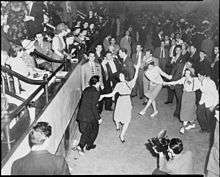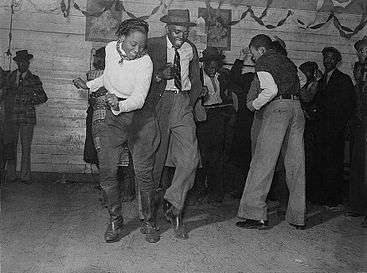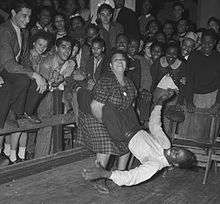Jitterbug

The jitterbug is a kind of dance popularized in the United States in the early 20th century, and is associated with various types of swing dances such as the Lindy Hop,[1] jive, and East Coast Swing.
Origin

According to the Oxford English Dictionary (OED) the word "jitterbug" is a combination of the words "jitter" and "bug";[2][3] both words are of unknown origin.[4][5][6]
The first use of the word "jitters" quoted by the OED is from 1929, Act II of the play Strictly Dishonorable by Preston Sturges where the character Isabelle says: "Willie's got the jitters" is answered by a judge "Jitters?" to which Isabelle answers "You know, he makes faces all the time."[4][7] The second quote in the OED is from the N.Y. Press from 2 April 1930: "The game is played only after the mugs and wenches have taken on too much gin and they arrive at the state of jitters, a disease known among the common herd as heebie jeebies."[4][8]
According to H. W. Fry in his review of Dictionary of Word Origins by Joseph Twadell Shipley in 1945 the word "jitters" "is from a spoonerism ['bin and jitters' for 'gin and bitters']...and originally referred to one under the influence of gin and bitters".[7]
Wentworth and Flexner explains "jitterbug" as "[o]ne who, though not a musician, enthusiastically likes or understands swing music; a swing fan" or "[o]ne who dances frequently to swing music" or "[a] devotee of jitterbug music and dancing; one who follows the fashions and fads of the jitterbug devotee... To dance, esp[ecially] to jazz or swing music and usu[ally] in an extremely vigorous and athletic manner".[7]
The first quote containing the word "jitterbug" recorded by the OED is from 1934 is the Cab Calloway song titled "Jitter Bug" and they quote the 1934 song printed in Song Hits magazine on 19 November 1939 as: "They're four little jitter bugs. He has the jitters ev'ry morn, That's why jitter sauce was born."[2]
Early history

Cab Calloway's 1934 recording of "Call of the Jitter Bug" (Jitterbug)[9] and the film "Cab Calloway's Jitterbug Party"[10] popularized use of the word "jitterbug" and created a strong association between Calloway and jitterbug. Lyrics to "Call of the Jitter Bug" clearly demonstrate the association between the word jitterbug and the consumption of alcohol:
If you'd like to be a jitter bug,
First thing you must do is get a jug,
Put whiskey, wine and gin within,
And shake it all up and then begin.
Grab a cup and start to toss,
You are drinking jitter sauce!
Don't you worry, you just mug,
And then you'll be a jitter bug!
In the 1947 film Hi De Ho, Calloway includes the following lines in his song "Minnie the Moocher": "Woe there ain't no more Smokey Joe/ She's fluffed off his hi-de-ho/ She's a solid jitterbug/ And she starts to cut a rug/ Oh Minnie's a hep cat now."[11]
Regarding the Savoy Ballroom, dance critic John Martin of The New York Times wrote the following:
The white jitterbug is oftener than not uncouth to look at ... but his Negro original is quite another matter. His movements are never so exaggerated that they lack control, and there is an unmistakable dignity about his most violent figures...there is a remarkable amount of improvisation ... mixed in ... with Lindy Hop figures. Of all the ballroom dances these prying eyes have seen, this is unquestionably the finest.[12]
Norma Miller wrote, however, that when "tourists" came to the Savoy, they saw a rehearsed and choreographed dance, which they mistakenly thought was a regular group of dancers simply enjoying social dancing.[13]
One text states that "the shag and single lindy represented the earlier popular basics" of jitterbug, which gave way to the double lindy when rock and roll became popular.[14]
A young, white middle-class man from suburban Pittsburgh, Pennsylvania learned to dance jitterbug in 1939 by going to the "Hill City" section of that city to watch black dancers. They danced smoothly, without hopping and bouncing around the dance floor.
The hardest thing to learn is the pelvic motion. I suppose I always felt these motions are somehow obscene. You have to sway, forwards and backwards, with a controlled hip movement, while your shoulders stay level and your feet glide along the floor. Your right hand is held low on the girl's back, and your left hand down at your side, enclosing her hand.[15]
When he ventured out into "nearby mill towns, picking up partners on location", he found that there were white girls who were "mill-town...lower class" and could dance and move "in the authentic, flowing style". "They were poor and less educated than my high-school friends, but they could really dance. In fact, at that time it seemed that the lower class a girl was, the better dancer she was, too."[15]
A number called "The Jitterbug" was written for the 1939 film The Wizard of Oz. The "jitterbug" was a bug sent by the Wicked Witch of the West to waylay the heroes by forcing them to do a jitterbug-style dance. Although the sequence was not included in the final version of the film, the Witch is later heard to tell the flying monkey leader, "I've sent a little insect on ahead to take the fight out of them." The song as sung by Judy Garland as Dorothy and some of the establishing dialogue survived from the soundtrack as the B-side of the disc release of "Over the Rainbow".
Popularity
In 1944, with the United States' continuing involvement in World War II, a 30% federal excise tax was levied against "dancing" night clubs. Although the tax was later reduced to 20%, "No Dancing Allowed" signs went up all over the country. Jazz drummer Max Roach argued that, "This tax is the real story why dancing ... public dancing per se ... were [sic] just out. Club owners, promoters, couldn't afford to pay the city tax, state tax, government tax."[16]
World War II facilitated the spread of jitterbug across the Pacific and the Atlantic Oceans. British Samoans were doing a "Seabee version" of the jitterbug by January 1944.[17] Across the Atlantic in preparation for D-Day, there were nearly 2 million American troops stationed throughout Britain in May 1944.[18] Ballrooms that had been closed because of lack of business opened their doors. Working class girls who had never danced before made up a large part of the attendees, along with American soldiers and sailors. By November 1945 after the departure of the American troops following D-Day, English couples were being warned not to continue doing energetic "rude American dancing."[19] Time reported that American troops stationed in France in 1945 jitterbugged,[20] and by 1946, jitterbug had become a craze in England.[21] It was already a competition dance in Australia.[22]
A United Press item datelined Hollywood on 9 June 1945 stated that dancer Florida Edwards was awarded a $7,870 judgement by the district court of appeals for injuries she sustained while jitterbugging at the Hollywood Canteen the previous year.[23][24]
Jitterbug dancing was also done to early rock and roll. Rockabilly musician Janis Martin equated jitterbug with rock and roll dancing in her April 1956 song "Drugstore Rock 'n' Roll":
In 1957, the Philadelphia-based television show American Bandstand was picked up by the American Broadcasting Company and shown across the United States. American Bandstand featured currently popular songs, live appearances by musicians and dancing in the studio. At this time, the most popular fast dance was jitterbug, which was described as "a frenetic leftover of the swing era ballroom days that was only slightly less acrobatic than Lindy".[28]
Blues musician Muddy Waters did a jitterbug during his performance at the 1960 Newport Jazz Festival, prompting massive cheers from the audience. His performance was recorded, and released on the LP At Newport 1960.
In a 1962 article in the Memphis Commercial Appeal, Bassist Bill Black, who had backed Elvis Presley from 1954 to 1957, and now the leader of the Bill Black Combo listed "jitterbug" along with the twist and cha-cha as "the only dance numbers you can play".[29]
See also
References
- ↑ Manning, Frankie; Cynthia R. Millman (2007). Frankie Manning: Ambassador of Lindy Hop. Philadelphia, Pennsylvania: Temple University Press. p. 238. ISBN 1-59213-563-3.
- 1 2 "jitterbug, n. in Oxford English Dictionary". Subscription service. Oxford University Press. Retrieved 7 November 2014.
- ↑ "jitterbug, v. in Oxford English Dictionary". Subscription service. Oxford University Press. Retrieved 7 November 2014.
- 1 2 3 "jitter, n. in Oxford English Dictionary". Subscription service. Oxford University Press. Retrieved 7 November 2014.
- ↑ "jitter, v.. in Oxford English Dictionary". Subscription service. Oxford University Press. Retrieved 7 November 2014.
- ↑ "bug, n.2 in Oxford English Dictionary". Subscription service. Oxford University Press. Retrieved 7 November 2014.
Etymology unknown. Usually supposed to be a transferred sense of BUG n.1; but this is merely a conjecture, without actual evidence, and it has not been shown how a word meaning 'object of terror, bogle', became a generic name for beetles, grubs, etc. Sense 1 shows either connection or confusion with the earlier budde ; in quot. 1783 at sense 1 shorn bug appears for Middle English scearn-budde (-bude) < Old English scearn-budda dung beetle, and in Kent the 'stag-beetle' is still called shawn-bug. Compare Cheshire 'buggin, a louse' (Holland).
- 1 2 3 Wentworth, Harold and Stuart Berg Flexner, ed. (1975). Dictionary of American Slang (2nd ed.). New York: Thomas Y. Crowell Company. p. 293. ISBN 0690006705.
1945: "[The term] is from a Spoonerism ['bin and jitters' for 'gin and bitters'] ... and originally referred to one under the influence of gin and bitters" H. W. Fry, rev. of J. T. Shipley's Dict. of Word Origins, Phila. Bulletin, Oct. 16. B22.
- ↑ According to The Oxford English Dictionary heebie-jeebie means "A feeling of discomfort, apprehension, or depression; the 'jitters'; delirium tremens; also, formerly, a type of dance."
- ↑ "Archived copy". Archived from the original on 1 January 2013. Retrieved 1 September 2007.
- ↑ "Wild Realm Reviews: Cab Calloway". www.weirdwildrealm.com.
- ↑ "Wild Realm Reviews: Cab Calloway". Weirdwildrealm.com. Retrieved 2014-02-14.
- ↑ Stearns, Marshall and Jean (1968). Jazz Dance: The Story of American Vernacular Dance. New York: Macmillan. page 331. ISBN 0-02-872510-7
- ↑ Swinging at the Savoy. Norma Miller. page 63.
- ↑ Dance a While: Handbook of Folk, Square, and Social Dancing. Fourth Edition. Harris, Pittman, Waller. 1950, 1955, 1964, 1968. Burgess Publishing Company. No ISBN or catalog number. page 284.
- 1 2 Stearns, Marshall and Jean (1968). Jazz Dance: The Story of American Vernacular Dance. New York: Macmillan. page 330. ISBN 0-02-872510-7
- ↑ Stomping the Blues. By Albert Murray. Da Capo Press. 2000. pages 109, 110. ISBN 0-252-02211-4, ISBN 0-252-06508-5
- ↑ Popular Science, January 1944. "The Seabees Can Do It". page 57.
- ↑ Ambrose, Stephen (1994). D-Day, June 6, 1944: The Climactic Battle of World War II. New York: Touchstone. p. 151. ISBN 0-671-67334-3.
- ↑ Billboard, 24 November 1945. "Britons Drive to End Jiving as Yanks Go Home". page 88
- ↑ "U.S. At War: G.I. Heaven". Time. 18 June 1945.
- ↑ "BBC iPlayer - Error". BBC iPlayer.
- ↑ "Muscle beach party - Arts - Entertainment - smh.com.au". www.smh.com.au.
- ↑ United Press, no headline, The San Bernardino Daily Sun, San Bernardino, California, Sunday 10 June 1945, Volume 51, page 6.
- ↑ https://law.justia.com/cases/california/supreme-court/2d/27/802.html
- ↑ "Archived copy". Archived from the original on 1 February 2013. Retrieved 5 December 2009.
- ↑ "Drugstore rock 'n' roll - Janis Martin". www.rockabilly.nl.
- ↑ http://rcs-discography.com/rcs/ss/02/ss2800.mp3
- ↑ Shore, Michael; Dick Clark (1985). The History of American Bandstand. New York: Ballantine Books. pp. 12, 54. ISBN 0-345-31722-X.
- ↑ The Blue Moon Boys: The Story of Elvis Presley's Band. Ken Burke and Dan Griffin. 2006. Chicago Review Press. page 146. ISBN 1-55652-614-8.